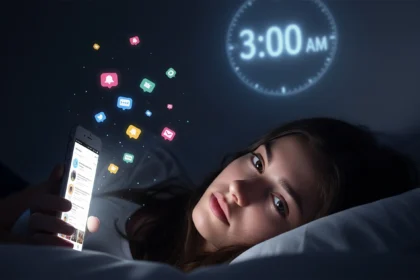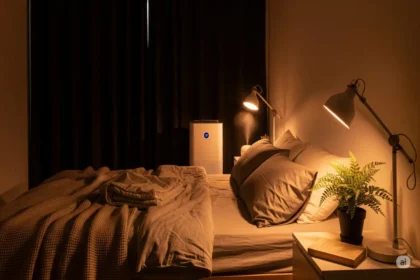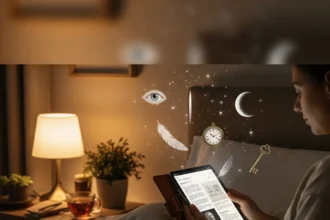The elusive spark of inspiration, the sudden breakthrough in a complex problem, the novel idea that seems to arrive fully formed – these moments of creative genius often feel serendipitous, almost magical. We tend to attribute them to intense focus, relentless effort, or perhaps a sudden stroke of luck. Yet, a growing body of scientific evidence points to a surprising, often overlooked, architect of innovation: sleep. The profound and often counterintuitive link between Sleep & Creativity reveals that our most imaginative and insightful moments frequently emerge not from tireless work, but from the quiet, restorative processes of the night.
Imagine a musician struggling with a melody, a writer grappling with a plot twist, or a scientist stuck on a perplexing hypothesis. They might toil for hours, feeling increasingly frustrated. Then, exhausted, they finally surrender to sleep. The next morning, perhaps over coffee, the solution, the perfect chord progression, or the elegant scientific model suddenly appears, clear as day. This isn’t coincidence; it’s the brain’s nocturnal alchemy at work, transforming fragmented thoughts into coherent insights. This phenomenon has been observed for centuries, long before neuroscientists could peer into the sleeping brain, hinting at sleep’s indispensable role in unlocking our inner genius.
The Brain’s Creative Workshop: A Tour Through Sleep Stages
To understand how sleep fuels creativity, we must first appreciate the intricate architecture of our nocturnal rest. Sleep is not a monolithic block of unconsciousness but a dynamic journey through distinct stages, each contributing uniquely to cognitive function, including our creative capacity. Our sleep cycles, typically lasting around 90 minutes, alternate between Non-Rapid Eye Movement (NREM) sleep and Rapid Eye Movement (REM) sleep.
NREM Sleep: The Foundation for Insight
NREM sleep, particularly its deeper stages, lays crucial groundwork for creativity.
- N2 (Deeper Sleep): This stage is characterized by “sleep spindles,” bursts of brain activity that are believed to play a role in consolidating newly learned information. While not directly creative, consolidating existing knowledge is vital. Creativity often involves combining disparate pieces of information in novel ways, and sleep spindles help to strengthen and organize these individual pieces, making them more accessible for later recombination.
- N3 (Slow-Wave Sleep – SWS): This is the deepest and most restorative stage of NREM sleep. During SWS, the brain actively replays recent experiences and learning, transferring memories from the hippocampus (a temporary storage hub) to the neocortex (the brain’s long-term filing cabinet). This process, known as memory consolidation, is crucial because it frees up space in the hippocampus for new learning and strengthens the neural connections that form the building blocks of our knowledge. A well-organized “filing cabinet” is essential for creative thinking, as it provides the raw material for new connections. Research from the University of Lübeck in Germany, for example, has shown that SWS is particularly important for consolidating “implicit” memories—those underlying skills and procedures—which can then be flexibly applied in creative problem-solving.
REM Sleep: The Crucible of Innovation
While NREM sets the stage, REM sleep is often considered the primary engine of nocturnal creativity. This is the stage of vivid dreaming, characterized by intense brain activity, similar to wakefulness, but with the body’s muscles temporarily paralyzed (atonia).
- Associative Thinking: During REM sleep, the brain exhibits a heightened ability to make novel connections between seemingly unrelated concepts. Unlike waking thought, which is often constrained by logic and linear progression, REM sleep allows for a more fluid, associative, and even bizarre recombination of ideas. This “free association” is a hallmark of creative thinking, enabling the brain to explore a wider range of possibilities and break free from conventional thought patterns. Dr. Robert Stickgold, a Harvard Medical School professor, has conducted extensive research demonstrating REM sleep’s role in this type of associative learning.
- Emotional Processing: REM sleep is also crucial for processing emotional experiences. This emotional regulation can indirectly boost creativity by reducing anxiety and stress, which often inhibit divergent thinking. A calmer, more integrated emotional state allows the mind to be more open to new ideas and less constrained by fear of failure.
- Problem-Solving: Many anecdotal accounts and scientific studies point to REM sleep as a prime time for solving problems that have stumped us during the day. The brain, free from external distractions and logical constraints, can re-evaluate information and find solutions that were previously elusive. This is often referred to as “insight learning” or “aha! moments.”
Historical Echoes: Geniuses Who Slept on It
The intuitive understanding of sleep’s creative power is not new; history is rich with examples of brilliant minds who leveraged their nocturnal rest for breakthroughs.
- Dmitri Mendeleev: The Russian chemist famously reported that the complete arrangement of the periodic table came to him in a dream after he had been struggling with it for years. He awoke, jotted it down, and made only one small correction later.
- August Kekulé: The German organic chemist struggled for a long time to understand the structure of benzene. One evening, he dozed off by the fire and dreamed of a snake biting its own tail, forming a ring. This vision led him to the groundbreaking discovery of benzene’s ring structure.
- Salvador Dalí: The eccentric surrealist painter famously employed a “slumber with a key” technique. He would sit with a metal plate on the floor and hold a heavy key between his fingers. As he drifted into the hypnagogic state (the transition between wakefulness and sleep), the key would drop, clanging against the plate and waking him. Dalí believed this brief dip into the borderland of sleep, where bizarre and illogical thoughts emerge, was a rich source of creative inspiration for his surrealist art.
- Paul McCartney: The legendary Beatle famously woke up one morning with the melody for “Yesterday” fully formed in his head. He initially feared he had plagiarized it, so perfect and complete did it seem, but it was entirely his own, a gift from his sleeping mind.
These anecdotes, while not direct scientific proof, offer compelling real-world examples of sleep’s role in fostering creative breakthroughs.
The Scientific Mechanisms: How It Works
Modern neuroscience provides a deeper understanding of the neural mechanisms underlying sleep’s creative boost.
- Synaptic Homeostasis Hypothesis: Proposed by Dr. Giulio Tononi and Dr. Chiara Cirelli, this theory suggests that during waking hours, our synapses (the connections between neurons) strengthen with every new experience, leading to a state of “synaptic potentiation.” This is metabolically expensive and can lead to neural “noise.” During NREM sleep, particularly SWS, there’s a global synaptic downscaling, where weaker, less important connections are pruned, and stronger, more relevant ones are refined. This process is like defragmenting a computer hard drive, clearing out clutter and making the system more efficient. This “reset” allows the brain to be more receptive to new learning and to make novel connections during subsequent wakefulness or REM sleep.
- Memory Replay and Reorganization: As mentioned, during NREM sleep, neural patterns associated with new learning are replayed. This replay isn’t just a simple repetition; it’s a process of transferring memories from the hippocampus to the neocortex, where they become integrated into our existing knowledge networks. During REM sleep, this reorganization continues, but with a more flexible, associative quality. The brain can “mix and match” elements of different memories, leading to insights and novel combinations.
- Neurotransmitter Modulation: Sleep also involves significant changes in neurotransmitter levels. For example, during REM sleep, levels of norepinephrine (a stress-related neurotransmitter that can inhibit creative thinking) are very low, while acetylcholine levels are high. This unique neurochemical environment is thought to facilitate the associative, non-linear thinking characteristic of creativity.
Optimizing Sleep for Creative Flow
Given sleep’s profound impact on creativity, how can we leverage it?
- Prioritize Sufficient Sleep: The most fundamental step is simply getting enough sleep – generally 7-9 hours for adults. Chronic sleep deprivation is a creativity killer, impairing attention, memory, and flexible thinking.
- Embrace Naps: Strategic naps, particularly those long enough to include REM sleep (around 90 minutes), can be powerful creative tools. Even shorter power naps (10-20 minutes) can clear mental fog and improve focus, setting the stage for creative work.
- “Sleep on It”: When faced with a creative block or a difficult problem, consciously decide to “sleep on it.” Engage with the problem before bed, perhaps reviewing relevant information, then allow your sleeping brain to work its magic. Keep a notebook by your bed to capture any ideas that emerge upon waking.
- Maintain a Consistent Sleep Schedule: Regular sleep-wake times help regulate your circadian rhythm, leading to more stable and efficient sleep cycles, which in turn optimize the brain’s nocturnal creative processes.
Conclusion: The Unseen Wellspring of Genius
The surprising link between sleep and creativity is a testament to the extraordinary, often unseen, work our brains perform each night. It challenges the notion that productivity is solely a function of waking hours and continuous effort. Instead, it reveals sleep as an active, indispensable partner in the creative process, a hidden wellspring from which new ideas, insights, and solutions emerge.
From the ancient dreams that inspired scientific breakthroughs to the modern understanding of neural reorganization during REM sleep, the evidence is clear: to unlock your inner genius, you must first honor your need for rest. So, the next time you feel creatively stuck, resist the urge to push harder. Instead, surrender to the profound power of sleep. Allow your brain to wander, to connect, to reorganize. You might just wake up to the most brilliant idea you’ve ever had, a true testament to the quiet, revolutionary power of a well-rested mind.
Disclaimer: The information provided in this article is for general informational purposes only and does not constitute medical advice. It is not a substitute for professional medical advice, diagnosis, or treatment. Always seek the advice of your physician or other qualified health provider with any questions you may have regarding a medical condition. Never disregard professional medical advice or delay in seeking it because of something you have read on this website.














